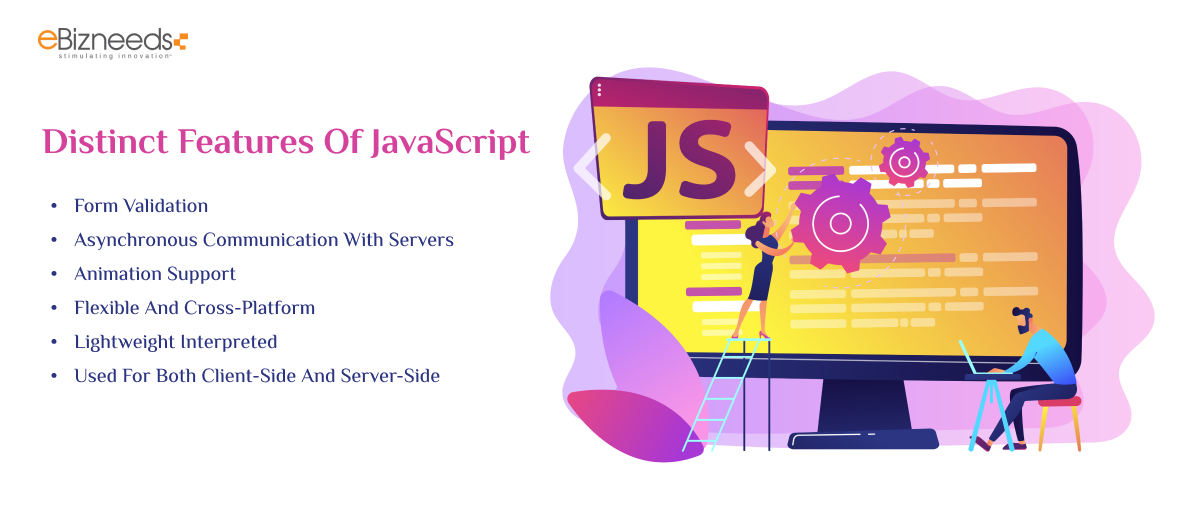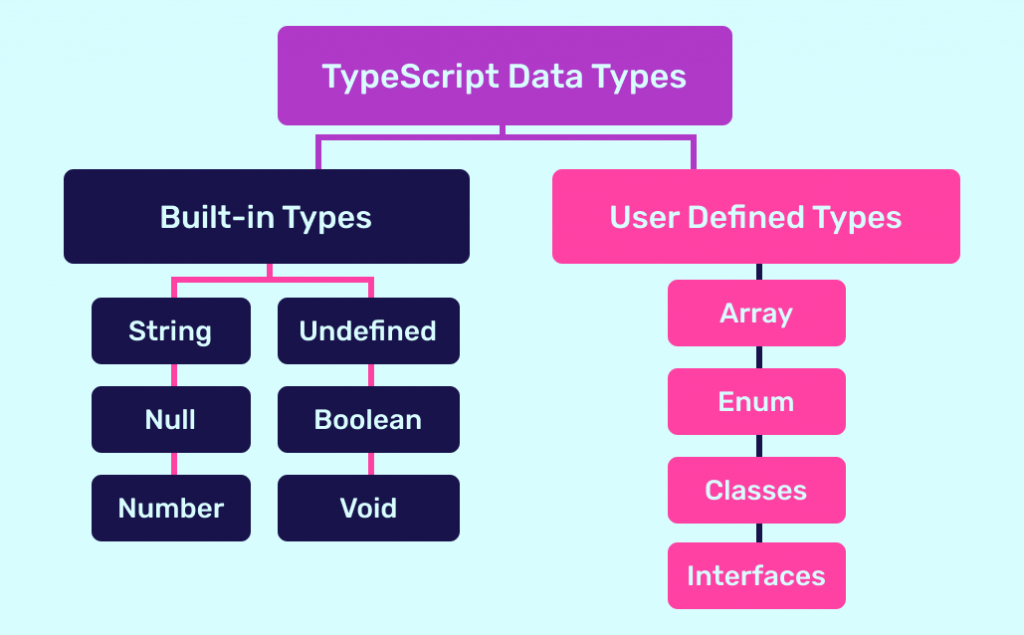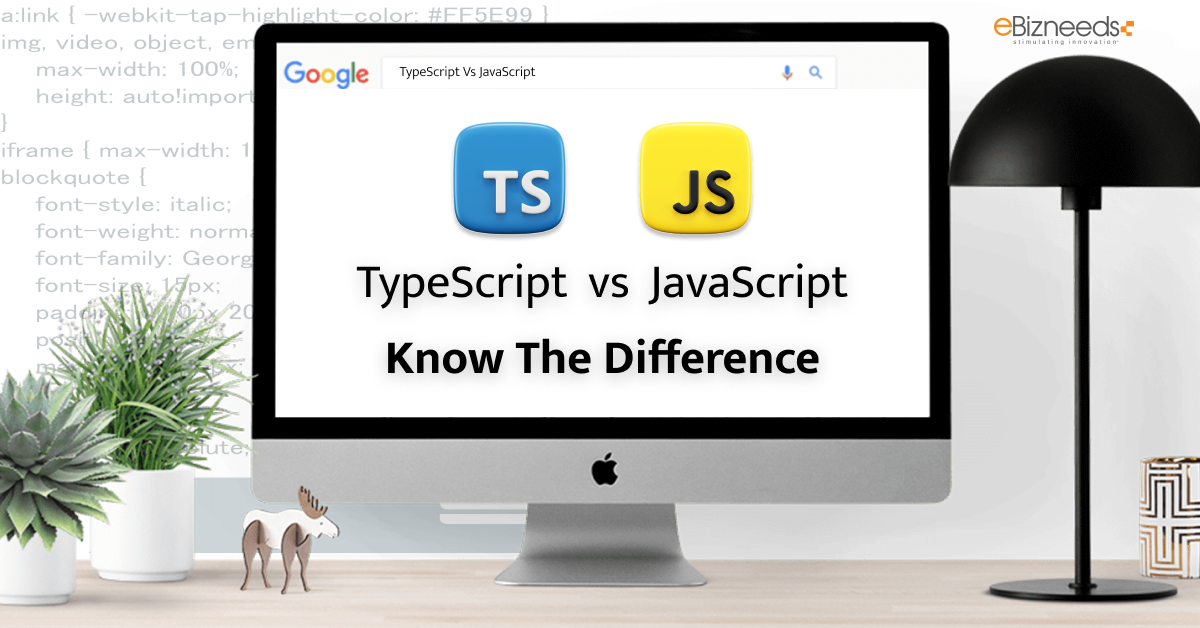Are you thinking of developing a web application for your business? Do you want to get the best product? Are you confused about which programming language to consider for front-end development? Well, if you want professional guidance then we are here to help. eBizneeds provides professional developers for hire that suit your project needs. So, returning to the question of which programming language to choose between TypeScript and JavaScript, we have created this blog. So, in this blog on TypeScript vs JavaScript, we will discuss all essential points.
JavaScript – An Overview
JavaScript is a programming language that was developed in 1995 to develop interactive and dynamic web pages. Since then, it has become a fundamental part of web development and by the end of 2023, almost 98% of websites use JavaScript. It is a client-side scripting language that directly runs on the browser, enabling developers to make changes in DOM and respond to user actions. Moreover, you can also use this with other popular technologies like CSS, XML, HTML, and REST APIs.
With the increasing use of Node.js Development Solutions, the server side uses JavaScript and enables developers to build full-stack applications. The compatibility and widespread use across browsers makes JavaScript an important asset of modern web development services. However, continuous enhancements and updates, ensure its relevance and responsiveness in the evolving technological landscapes.
Features of JavaScript



JavaScript, being a dynamic and versatile programming language, offers a variety of features in web development. Here is an in-depth explanation of some key features:
Dynamic Typing
JavaScript uses dynamic typing according to which variable types are determined during runtime. However, this flexibility allows developers to use variables without specifying their types clearly. This simplifies the coding process for the developers.
Interactivity
Being a client-side scripting language, JavaScript allows responsive and interactive user interface creation. So, it can enable changes in the document object model (DOM) while allowing developers to dynamically update and modify the webpage content on user interactions.
Asynchronous Programming
JavaScript has capabilities like await/async, promises, and callbacks that enable asynchronous programming. This is essential for managing operations like obtaining data from servers without obstructing the execution of other programs. Finally, this improves the overall performance of web applications.
Event Handling
JavaScript makes event-driven programming easier by enabling programmers to react to a range of events. It includes system events and user activities like clicks and keystrokes. However, developing engaging and user-friendly programs requires this functionality.
First-Class Citizens
Functions in JavaScript can be assigned to variables, supplied as arguments to other functions, and returned as values. This is because they are regarded as first-class citizens. This feature of functional programming facilitates the development of higher-order functions and improves the code modularity.
Prototype-Based Inheritance
JavaScript allows objects to directly inherit attributes and behaviors from other objects through the use of a prototype-based inheritance mechanism. Finally, this offers an effective and adaptable method for setting up and maintaining object hierarchies.
JavaScript CLosures
When a function completes its execution, it can still access variables from its outer space. This is all because of closure support which comes particularly handy for preserving state inside functions and establishing private variables.
Scalability with Node.JS
JavaScript has spread its reach beyond the browser with the rise of Node.JS which is a server-side runtime environment. This enables developers to use JavaScript to build scalable and efficient server-side applications. Thus, fostering the development of full-stack solutions with Node.js development services.
Types of JavaScript
JavaScript has several primitive and other types that represent the kind of data a variable can hold. Some types in JavaScript are:
Primitive Categories
- Textual data is represented as a string and is surrounded by single (“”) or double (“”) quotes.
- Number: Denotes any numeric value, including floating-point and integer values.
- Boolean: Denotes a true or false logical value.
- Null: Denotes the deliberate removal of all object values.
- Undefined: Denotes a value that has not been initialized or defined.
Symbols
They are distinct, unchangeable values that are frequently used as object property identifiers. They were first introduced in ECMAScript 6 (ES6).
Object
Capable of storing key-value pairs, objects are sophisticated data types. Curly braces {} can be used to create objects.
Array
Arrays are a class of objects used to hold data sets in an ordered fashion. Any sort of element can be found in an array, and an index is used to retrieve each element.
Function
Functions in JavaScript can be used to perform a specific task. They can be assigned to variables, returned as values, and passed as arguments.
Date
Represents time and date. JavaScript provides a “Date” object for working with dates.
Advantages Of Choosing JavaScript
Being the foundation of web development, several advantages contribute to the popularity of JavaScript. Here are some key advantages explained:
Versatility for Front-End Development
JavaScript is mainly known for its role in enhancing the responsiveness and interactivity of websites. As a scripting language, it allows developers to manipulate the DOM. This allows dynamic updates to webpage content without requiring a page reload. However, this versatility is crucial for creating interactive web applications and engaging user interfaces.
Wide Browser Support
One of JavaScript’s significant strengths is its compatibility with major web browsers. Whether it is Chrome, Edge, Safari, or Firefox, JavaScript code runs consistently across different browsers. It also ensures a seamless user experience for both developers and clients. This cross-browser compatibility reduces development efforts and makes JavaScript a reliable choice for a Node.JS Development Company.
Asynchronous Programming Compatibilities
JavaScript supports asynchronous programming which is a key feature for handling tasks such as data fetching, file operations, and API calls without blocking the execution of other code. This asynchronous nature, facilitated by mechanisms like callbacks, promises, and async/await, enhances the efficiency and responsiveness of web applications.
Rich Ecosystem of Libraries and Frameworks
The JavaScript ecosystem attains an extensive collection of libraries and frameworks, such as React, Angular, and Vue.js for front-end development, and Node.js for server-side development. These tools provide developers with pre-built components, modular structures, and efficient workflows. Finally, accelerates the development process and promotes code reusability.
Community Support and Resources
JavaScript has a vibrant and active community of developers who contribute to forums, share knowledge, and create open-source projects. This community support translates into a wealth of online resources, tutorials, and documentation. Moreover, this makes it easier for developers to find solutions, stay updated with best practices, and collaborate on projects.
Scalability with Node.js
The advent of Node.js extends JavaScript beyond the browser, allowing developers to use the same language for both front-end and server-side development. This full-stack capability streamlines the development process, facilitates code sharing, and promotes scalability by handling large numbers of simultaneous connections efficiently.
Dynamic Typing and Flexibility
JavaScript’s dynamic typing enables developers to write more flexible and adaptable code. Variables do not have fixed types, allowing for seamless transitions between different data types. In fact, this flexibility promotes rapid development and accommodates changes in project requirements.
Regular Updates and ECMAScript Standards
JavaScript evolves through regular updates and adherence to ECMAScript standards. These updates introduce new features, syntax enhancements, and improved language capabilities. Staying current with the latest ECMAScript specifications ensures developers have access to modern language features and can take advantage of advancements in the language.
Why Use JavaScript?
JavaScript is a widely adopted programming language for web development. Its use is driven by several compelling reasons that contribute to its popularity and effectiveness in building modern web applications. Additionally, let’s read the key reasons to use JavaScript:
- Client-Side Interactivity
- Cross-browser compatibility
- Asynchronous Programming
- Extensive Ecosystem
- Full-Stack Development with Node.js
- Community Support
- Regular Updates and Standards Compliance
- Versatility in Use Cases
- Job Opportunities and Market Demand
TypeScript – An Overview
TyperScript is an open-source programming language that was developed and maintained by Microsoft. It is a superset of JavaScript that contains optional typing while complying with plain JavaScript. Moreover, TypeScript is a compiled programming language that is used for writing concise and clear JavaScript codes. Thus, it has similar features to JavaScript buy in an advanced manner, along with the compatibility of JavaScript libraries.
This programming language supports both static and dynamic typing, providing namespaces, interfaces, visibility scopes, and union-like features. TypeScript also offers developers with statements, modules, functions, comments, and expressions. If you are into Node.js Development, then TypeScript is the best choice.
Features of TypeScript
While providing features of JavaScript, TyoeScript offers some amazing and advanced features. Let us have a look at some of the top features of TypeScript below:
Static Typing
TypeScript introduces static typing, enabling developers to specify variables, function parameters, and return types. This feature allows for early detection of type-related report errors during development rather than runtime, contributing to code robustness.
Type Inference
TypeScript incorporates a sophisticated type inference system, capable of deducing variable and expression types without explicit declarations. This feature reduces the need for excessive type annotations, making the code more concise while maintaining type safety.
The language supports interfaces, providing a powerful mechanism to define contracts for object shapes. Interfaces enhance code maintainability by enforcing a consistent structure for objects and promoting better documentation practices.
Classes and Generics
TypeScript supports object-oriented programming features, including classes, inheritance, and interfaces. This facilitates the organization and structuring of code, particularly in larger applications.
TypeScript introduces generics, enabling developers to write reusable and type-safe code. Generics allow the creation of functions and classes that can work with various data types while maintaining type integrity.
Modules
The language supports the creation of union and intersection types, providing flexibility when working with different data types. This contributes to code expressiveness and adaptability.
TypeScript facilitates modular development through the use of namespaces and modules. This feature promotes better code organization and maintainability, especially in large codebases.
Type Annotations & Decorators
Developers can explicitly annotate types for variables, parameters, and return values, enhancing code documentation and providing improved tooling support for development environments.
TypeScript supports decorators, allowing developers to attach metadata to classes, methods, and properties. Decorators are widely utilized in frameworks like Angular, enabling the extension and customization of class behavior.
Tooling Support
TypeScript enjoys excellent tooling support, particularly in popular code editors like Visual Studio Code. This includes features such as intelligent code completion, type checking, and refactoring tools, enhancing the developer experience.
TypeScript serves as a superset of JavaScript, enabling a seamless migration path for existing JavaScript code. This compatibility allows TypeScript files to coexist and integrate smoothly with JavaScript projects.
Advantages of TypeScript
TypeScript is a superset of JavaScript adds static typing to the language. This means that TypeScript code can be checked for errors at compile-time, providing several advantages over traditional JavaScript. Finally, here are some detailed advantages of TypeScript:
Static Typing
In traditional JavaScript, variables are dynamically typed, meaning their types are determined at runtime. TypeScript introduces static typing, allowing developers to declare the types of variables, and function parameters, and return values explicitly. The TypeScript compiler then checks these types during the compilation process. This early type checking helps catch errors before the code is executed, providing a more robust and predictable development experience.
Enhanced Code Quality
TypeScript enables developers to add type annotations to variables, functions, and other constructs. This makes the code more self-documenting and readable, as developers can understand the expected types without having to analyze the entire codebase. However, improved readability leads to better maintainability, as developers can quickly understand the purpose and behavior of different parts of the code.
Intelligent Code Editor Support:
TypeScript-aware editors, like Visual Studio Code, leverage the type information provided by TypeScript to offer advanced code completion. As developers type, the editor suggests relevant methods, properties, and types. Moreover, it reduces the likelihood of typos and provides a smoother development experience.
Refactoring
TypeScript’s static typing enhances the safety of refactoring operations. When developers rename variables, functions, or classes, the TypeScript compiler ensures that all references to the renamed entities are updated. This reduces the chances of introducing errors during refactoring and provides confidence when making changes to the codebase.
Tooling and IDE Support
TypeScript is well-integrated with various development tools and IDEs, providing a rich development experience. Features like error highlighting, code navigation, and documentation tooltips are enhanced by TypeScript’s static typing. Developers can leverage a wide range of plugins and extensions for popular editors, further enhancing their productivity.



Why Use TypeScript?
As we all know TypeScript is a superset of JavaScript, meaning it is an advanced and enhanced version of JavaScript. You can use any JavaScript file in TypeScript and the types available are also optional. You will get the JavaScript file in working condition even though you might have entered files that have type issues. The compiler will not notify you in this condition and you can have the file in hand. TypeScrit always fulfills the expectations is even simple for users and will help improve the skills of a developer.
TypeScript vs JavaScript: The Real Differences
There are so many factors that specify the difference between TypeScript and JavaScript. So, if you are in the situation of TypeScript vs JavaScript, read below to have a brief.
Performance
There were some challenges in using JavaScript for large-level complex applications. To overcome those challenges, TypeScript took the command and started providing the requested feature. Using TypeScript in your development process will save time and also allow you to become more efficient. The main difference between TypeScript and JavaScript is that every code written in TypeScript is compiled into JavaScript form before its execution.
Developers Community
TypeScript is very popular in enterprise-level industries with its implementation in several organizations. If you want to learn TypeScript then you can find several guides and tutorials available on the Internet. Moreover, the best part about TypeScript is its supportive and active community.
On the other hand, JavaScript is not so popular or has a small community when compared to TypeScrupt. Although, you will find many interesting features in JavaScaipt as we know TypesScript is a superior version of JavaScript, so it cannot be ahead. However, JavaSvript provides several other features like frameworks, code practices, and libraries. Therefore, it is advised to analyze your team structure and then fix it to the project requirement to enhance overall performance.
Tools & Frameworks
We know TypeScript is developed by Microsoft, and it has the support of leading editors and frameworks. This also provides issue handling during complications to resist errors at runtime. Talking about JavaScript frameworks, they are available to fulfill the requirements of web development projects. It has a huge database that is famous for modern programmers and you can quickly find developers who are experienced in VueJS, ReactJS, Angular, and other frameworks.
Learning Curve
A superset of JavaScript is TypeScript. It is necessary to have a fundamental understanding of JavaScript to write TypeScript code. Additionally, you must understand the idea of OOPS.
Conversely, JavaScript is a well-liked and simple-to-learn programming language. A lot of developers use HTML, CSS, and JavaScript to create online applications. But HTML is hard since it has scripting, animations, web behavior, and event management.
Head-to-Head Comparison: TypeScript vs JavaScript
|
TypeScript |
Parameters |
JavaScript |
|
TypeScript is a strong object-oriented programming language, with JS and additional features to overcome the complexities of JavaScript. |
Overview |
JS is a scripting language used to create dynamic webpages, it comes with first-class functions. |
|
Microsoft (2012) |
Developed By |
Brendan Eich (1995) |
|
Strong Typing Static & Dynamic Tying |
Type |
Loose Typing Only Dynamic Typing |
|
Utilizes interfaces and types to define employed data |
Data Binding |
No Data Binding |
|
TS is a very strong and intuitive programming language supporting static typing. |
Ecosystem |
JS is a simple language that performs code compatibility and is easy to read and write. |
|
You must have scripting language, as TS has a stiff learning curve. |
Learning Curve |
JS is a flexible language that is easy to learn. |
|
Used on Client-Side |
Client-Side or Server-Side |
Used on both Client-Side & Server-Side |
|
Supported |
Prototyping |
Not-Supported |
|
Smaller Community |
Community |
Larger community |
|
.ts & .tsx |
Files Extensions |
.js |
|
TypeScript Compilation is required |
Compilation |
JavaScript Compilation is not required. |
|
interface User { name: string; id: number; }
class UserAccount { name: string; id: number;
constructor(name: string, id: number) { this.name = name; this.id = id; } }
const user: User = new UserAccount(“Murphy”, 1); |
Examples |
function helloWorld() { alert(“Hello, World!”); } // Call the function helloWorld(); |


Conclusion
After detailing every single aspect of TypeScript and JavaScript in this blog, we are clear that both have their pros and cons. TypeScript is a great choice for developers who want to read and write clean codes as it provides static typing and live bug checking.
Moreover, JavaScript can be used with HTML to enhance the code quality. You can hire Node.js developers who have good experience in JavaScript coding. Now, you can make a clear choice based on your project requirements and begin the development process.
FAQs
TypeScript was developed to address certain limitations and challenges in JavaScript, particularly in large-scale application development. JavaScript is a dynamically typed language, which can lead to runtime errors that are difficult to catch during development. TypeScript introduces static typing, providing developers with a way to catch potential errors at compile-time. Additionally, TypeScript supports modern ECMAScript features and adds features like interfaces and advanced tooling, making it more robust and maintainable for larger projects.
TypeScript is suitable for both frontend and backend development. On the front end, TypeScript can be used with popular frameworks like Angular, React, and Vue.js. Its static typing helps catch errors early in the development process, enhancing code quality. On the backend, you can use Node.js with TypeScript, enabling developers to use a consistent language across the entire stack. Thus, the ability to share code and types between frontend and backend can streamline development and improve code maintainability.
Both TypeScript and JavaScript are widely used, but their popularity varies based on the context. JavaScript remains the de facto language for web development, and its widespread adoption is evident in both frontend and backend ecosystems. However, TypeScript has gained popularity, especially in larger projects and enterprises, where the benefits of static typing and enhanced tooling are more pronounced. In fact, popularity depends on the specific needs of the project and the preferences of the development team.
Migrating a project to TypeScript can bring several benefits. The introduction of static typing helps catch potential bugs early in the development process, improving code quality and maintainability. Moreover, TypeScript’s tooling provides better code navigation and refactoring support. Additionally, migrating to TypeScript allows projects to leverage the latest ECMAScript features while maintaining compatibility with existing JavaScript code. Thus, the gradual adoption of TypeScript through incremental migration is also possible, making the transition smoother.
The choice between JavaScript and TypeScript depends on the project requirements and team preferences. JavaScript is a good fit for smaller projects and when quick prototyping is essential. TypeScript is a better choice for larger projects where the benefits of static typing, better tooling, and code organization are crucial. Additionally, teams familiar with object-oriented programming and static typing may prefer TypeScript, while those focusing on quick development and flexibility may opt for JavaScript.
TypeScript will not replace JavaScript but rather complement it. JavaScript remains the foundational language for web development, and TypeScript is a superset of JavaScript. TypeScript code can seamlessly coexist with JavaScript, and developers can choose to use TypeScript features where needed. While TypeScript is gaining popularity, JavaScript will continue to be in use, and the choice between them will depend on project requirements and developer preferences.



Naveen Khanna is the CEO of eBizneeds, a company renowned for its bespoke web and mobile app development. By delivering high-end modern solutions all over the globe, Naveen takes pleasure in sharing his rich experiences and views on emerging technological trends. He has worked in many domains, from education, entertainment, banking, manufacturing, healthcare, and real estate, sharing rich experience in delivering innovative solutions.




